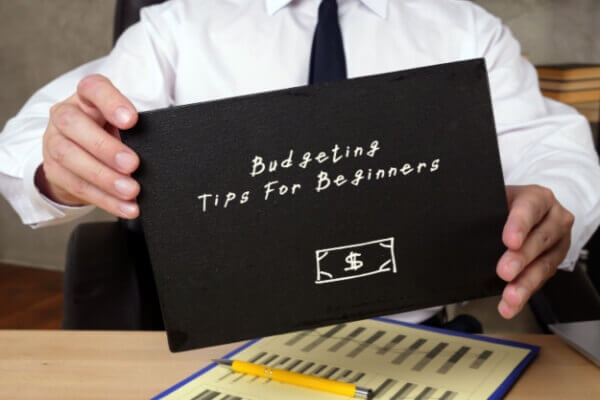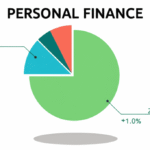It feels like a cage for money. A group of rules that take all the fun out of life and make you eat rice and beans while your friends are out having fun. Everyone hates doing it, but it’s the homework of being an adult.
But what if we’ve been looking at it the wrong way?
What if a budget isn’t a prison, but the key to getting out? What if it’s not about limiting, but about giving permission? I can tell you that the most successful people aren’t the ones who don’t spend money. I’ve seen the financial lives of thousands of people as a top financial writer. They are the ones who have a plan.
A budget is a way to plan how you will spend your money. You are the CEO of your life, and you tell your money exactly where to go so that you can reach your goals. It’s how you get rid of money stress and find peace. It’s how you can finally pay for that vacation, that down payment, or that priceless feeling of being in charge.
This is the first step in budgeting. Forget everything you think you know. This guide is over 4000 words long and has no fluff. It will give you the most complete and useful budgeting tips you can find online. We’ll show you how to make a budget from scratch, go over different ways to find the one that works best for you, and talk about the real reason most budgets fail: how people think.
Get ready to make your money your best tool for making a life you love instead of something that makes you anxious.
The “Why”: Budgeting Isn’t About Limiting Yourself; It’s About Making Plans
We need to make sure we know the “why” before we get into the “how.” If you see your budget as a punishment, you will never stick to it. You need to change the way you think.
A budget helps you be intentional. It gives you the power to:
- Get in Charge: You stop worrying about where your money went and start using it for a purpose. Going from being reactive to being proactive is the most important step you can take to get your finances in order.
- Lower Financial Stress: A 2023 report from the American Psychological Association found that money is a major source of stress for most adults. A budget is a direct way to get rid of this stress by giving you clarity and a sense of safety.
- Get to Your Goals Faster: A budget is the map that will help you get out of debt, save for a house, or travel the world. It helps you spend money in a way that fits with your long-term goals.
- Stop Arguing About Money: Money problems are one of the main reasons couples fight. A shared budget helps you work together toward the same goals by getting everyone on the same page.
Your budget lets you spend money on the things you care about without feeling guilty because you’ve already set aside money for them. It’s the best way to take care of your money.
Step 1: The Blueprint—Getting Your Financial Information
You can’t make a map if you don’t know the land. The first step in making your financial plan is to collect information. No judgment, no changes—just information.
Step 1: Keep track. Every. One. Cent.
You need to be a financial detective for at least 30 days. Your job is to keep track of every dollar that goes out of your accounts. You forgot about the $5 subscription, the $2 coffee, and the $20 you sent a friend for lunch. Everything.
- Tip #1 for budgeting: Use a simple tool. Don’t make this harder than it needs to be. You can use a small notebook, the notes app on your phone, a simple spreadsheet, or a tracking app that is made just for that.
- Tip #2 for Budgeting: Use Technology. Link your bank accounts to a free app like Mint or Empower Personal Dashboard. These tools automatically pull in and organize your transactions, so you only have to do 10% of the work.
This step is often a huge shock. You might find out that you’re spending $300 a month on takeout instead of the $100 you thought you were spending. This isn’t to make you feel bad; it’s to change “I think” to “I know.”
Step 2: Figure out how much money you really make
This might seem easy, but it can be hard. You need to know how much money you bring home each month after taxes, insurance, and other deductions.
- Tip #3 for Salaried Employees: This is usually pretty easy. Check your pay stubs to see how much money you actually made.
- **Tip #4 for budgeting: If your income varies or you work as a freelancer, check your bank deposits from the last 3–6 months. Find the average, but it’s usually better to *budget based on your lowest-earning month.* This gives you some extra money. You can put any money you make over that amount right toward your financial goals.
Step 3: Put the truth into groups and face it
Now, sort your 30 days of tracked spending into groups. You can be as detailed as you want, but start with the basics:
- Housing: Rent or mortgage, property taxes
- Utilities: Phone, internet, gas, water, and electricity
- Getting around: Gas, public transportation, car payments, insurance, and upkeep
- Food: Groceries, restaurants, and coffee shops
- Debt Payments: Credit cards, student loans, and personal loans
- Personal: Toiletries, haircuts, and shopping
- Fun: Movies, concerts, and subscriptions to services like Netflix and Spotify
- Health: Gym, insurance premiums, and prescriptions
- Giving: Gifts and donations to charity
Add up the totals for each category after you’ve put them into groups. This is the time when you have to face the truth. This is the plan for your money right now.
Phase 2: The Architecture—Choosing Your Budgeting Method
It’s time to make your financial plan now that you have your blueprint. There is no one “best” budget; there is only the best budget for you. The method you choose will depend on your personality, way of life, and money situation.
Method 1: The 50/30/20 Rule is the first and easiest way to start.
Best for: People who are just starting out and want a simple, adaptable framework that doesn’t require a lot of tracking.
Senator Elizabeth Warren made the 50/30/20 budget famous. It’s not a strict budget; it’s more of a way to spend money. You divide your after-tax income into three groups:
- 50% for Needs: These are the things you need to live. You’d still have to pay for these even if you lost your job. Think about housing, basic utilities, food, and the least amount of debt you can pay.
- 30% for Wants: This is the money you spend on things you want. Going out to eat, doing hobbies, traveling, shopping, and using streaming services. This is the fun part!
- 20% for Savings & Debt: This is the part that will help you build your future. This means saving money for emergencies, paying off more debt than the minimum, and saving for retirement.
Tip #5 for Budgeting: If your “needs” are more than 50% of your income (which is common for people who live in expensive areas), you’ll need to make changes. You should do everything you can to protect that 20% savings bucket. This might mean that your “wants” category needs to be less than 30%.
Method 2: The Zero-Based Budget (The Hands-On Controller)
Best for people who pay attention to every little thing and want to keep track of every dollar and get the most out of their savings.
The basic idea behind this method is “Income – Expenses = Zero.” At the start of the month, you give every dollar you expect to make a “job.”
You’re not just keeping track of how much you’ve spent in the past; you’re also making a plan for how to spend every dollar in the future. You will put all of your $4,000 in income into different categories, like rent, groceries, savings, etc., until there is nothing left.
Tip #6 for budgeting: Use a separate tool. You can do this with a spreadsheet, but apps like You Need A Budget (YNAB) are made just for this and can make a big difference.
Tip #7 for budgeting: Make a “Miscellaneous” or “Buffer” category. Having a small buffer of $50 to $100 will help you pay for small, unexpected costs without throwing off your whole plan.
Method 3: The Envelope System (The Tactile Spender)
Best for: People who have trouble not spending too much on their debit or credit cards and need a physical barrier.
This system is based on cash and is often used with a zero-based budget. You take out the amount of cash you planned to spend on things like groceries, restaurants, gas, and entertainment at the start of the month and put it in labeled envelopes.
- $400 for the groceries envelope
- Envelope for restaurants: $150
- Gas Envelope: $100
Tip #8 for budgeting: When you go to the store, only take the grocery envelope. You can’t spend any more money in that category until the money in that envelope is gone. It makes a hard stop that a credit card swipe doesn’t. It works well on the mind.
Method 4: The “Pay Yourself First” or “Anti-Budget”
Best for: People who don’t like keeping track of every little thing and have a steady income.
This method turns the tables. You should focus on automating your savings goals first instead of keeping track of every expense.
- Choose how much you want to save, like 20% of your income.
- Set up an automatic transfer to send that amount from your checking account to your savings or investment accounts on the day you get paid.
- You can spend the rest of the money in your checking account however you want.
Tip #9 for budgeting: This only works if you don’t go into debt every month. You need a more detailed method if your automated savings make you rely on credit cards.
Phase 3: The Execution—Real-Life Budgeting Tips
Making the plan is one thing. Living it is a different story. Here are some useful tips for making your budget work in the real world.
Tips for Budgeting for Your Most Important Expense: Housing
- Tip #10 for budgeting: Follow the 28% Rule. A common rule of thumb says that you shouldn’t spend more than 28% of your gross monthly income on housing (rent or mortgage).
- Tip #11 for budgeting: Think about house hacking. If you own a home, renting out a spare room, basement, or garage can cut your housing costs by a lot or even get rid of them completely.
- Tip #12 for Budgeting: Look at Your Living Situation Again. If your housing costs are too high for your budget, moving to a place with a lower cost of living or a smaller home might be the best financial decision you can make.
How to Keep Your Grocery Bill Under Control
- Budgeting Tip #13: Make a Meal Plan Every Week. Before you go shopping, plan out your meals for the week. This stops people from buying things they don’t need and wasting food.
- Tip #14 for Budgeting: Don’t Go Shopping When You’re Hungry. There’s a reason it’s a cliché. You will buy more snacks that cost a lot but don’t taste good.
- Tip #15 for budgeting: Use “boring” staples. Make your meals around cheap, healthy staples like beans, lentils, rice, oats, and seasonal vegetables.
- Tip #16 for budgeting: Check your pantry first. Before you make a list, see what you already have. Make meals out of things that are about to go bad.
How to Cut Down on Your Utility and Subscription Costs
- Tip #17 for budgeting: Do a subscription audit. Use an app like Trim or go through your bank statements by hand to find and cancel subscriptions you don’t use.
- Tip #18 for budgeting: Talk to your cable, internet, and cell phone companies once a year. If you want to know about new promotions you might be eligible for, call the customer retention department. This works more often than you might think.
- Tip #19 for Saving Money: Be Energy Conscious. Unplug electronics, switch to LED bulbs, and turn down your thermostat a few degrees. Little things add up.
The Psychology: Why Budgets Don’t Work and How to Make Yours Work
This is the most important part of the whole guide. It’s more about behavior than math when it comes to a budget. This is how to win the mind game.
The problem is that your budget is too tight.
You will fight against your budget if it doesn’t let you have fun. You’re making it hard for yourself to succeed.
- **Tip #20 for budgeting: Set aside money for fun! Your budget *must* have a place for spending that doesn’t make you feel bad. It’s an important way to let off steam, whether it’s “Dining Out,” “Hobbies,” or “Whatever I Want.”
- Tip #21 for budgeting: Start with small changes. Don’t try to cut your restaurant spending by 80% right away. Try to cut it by 20%. Small, steady wins build up speed.
Issue: You and Your Partner Are Not on the Same Page
If you’re dating someone, your money is a team sport. Any budget will fail if there are financial secrets or arguments.
- Tip #22 for budgeting: Set aside time once a month for “money dates.” Take some time to go over your budget and goals together. Don’t make it a fight; make it a team meeting.
- Tip #23 for budgeting: Don’t combine bank accounts, but do combine goals. You don’t need to have a joint account for everything, but you do need to have shared goals.
- Tip #24 for Budgeting: Make Room for Personal Spending Money. Having “Yours,” “Mine,” and “Ours” accounts is a great idea. You each have your own spending money that you don’t have to ask about after putting money into the “Ours” for shared bills and goals.
Problem: Life Happens and You Lose Your Way
You had a great month planned, but then your car broke down. You feel like you failed and give up completely.
- Budgeting Tip #25: Your Budget Is a Living Document. You should be able to change your budget. If you have a big, unexpected expense, sit down and change your plan for the month. You could cut back on your “wants” category or put an extra savings goal on hold for a while.
- Tip #26 for budgeting: Make your emergency fund a top priority. This is what your emergency fund is for! It’s not a failure to use it; that’s the budget working. Then your main goal is to fill the fund again. This is a basic rule for managing your money.
- Budgeting Tip #27: The 48-Hour Rule. If you want to buy something that isn’t necessary and costs more than a certain amount (like $50), wait 48 hours before you do. This simple trick cuts down on impulse buying by a lot.
Advanced Budgeting Tips: How to Improve Your Financial Plan
You can use more advanced strategies once you know the basics.
- Tip #28 for Budgeting: Make Sinking Funds. Set aside money for big, predictable, but rare costs like car repairs, vacations, and holiday gifts. Take the total estimated cost and divide it by the number of months you have to save. Saving $100 a month for a year is much easier than finding $1,200 in December.
- Tip #29 for budgeting: Automate your investments. The main goal of budgeting is to free up money so you can build wealth. Set up automatic transfers not only to your savings account but also to your retirement and investment accounts. This makes it easy to build wealth.
- Tip #30 for budgeting: Make sure your budget matches your values. Look at how you spend your money. Does it show what you really care about in life? Your budget is off if you value experiences but are spending a lot of money on clothes you never wear. Use your budget to make a conscious decision to spend more on things that make you truly happy and fulfilled.
- Tip #31 for budgeting: Keep track of your net worth. Your net worth (assets minus liabilities) is the best way to see how well you’re doing with your money. A monthly or quarterly budget gives you a bigger picture than a daily budget. Tools like Empower Personal Dashboard can do this for you.
Your Journey Starts Now
You don’t just learn how to budget once; it’s a skill you need for life. It’s a habit. Some months will be great, and some months will be terrible. That’s fine. The goal is not to be perfect; it’s to make progress.
Today is the day to start. Not next week, not tomorrow. Get a notebook or download an app. Keep track of your money coming in and going out. Pick a method—any method—and give it a shot. The most important thing to remember about budgeting is to just start.
You can change the story of your money. You can make your life less stressful, more free, and full of new opportunities. A plan for your money is the first and most important step. You need to make a plan for your financial freedom.




